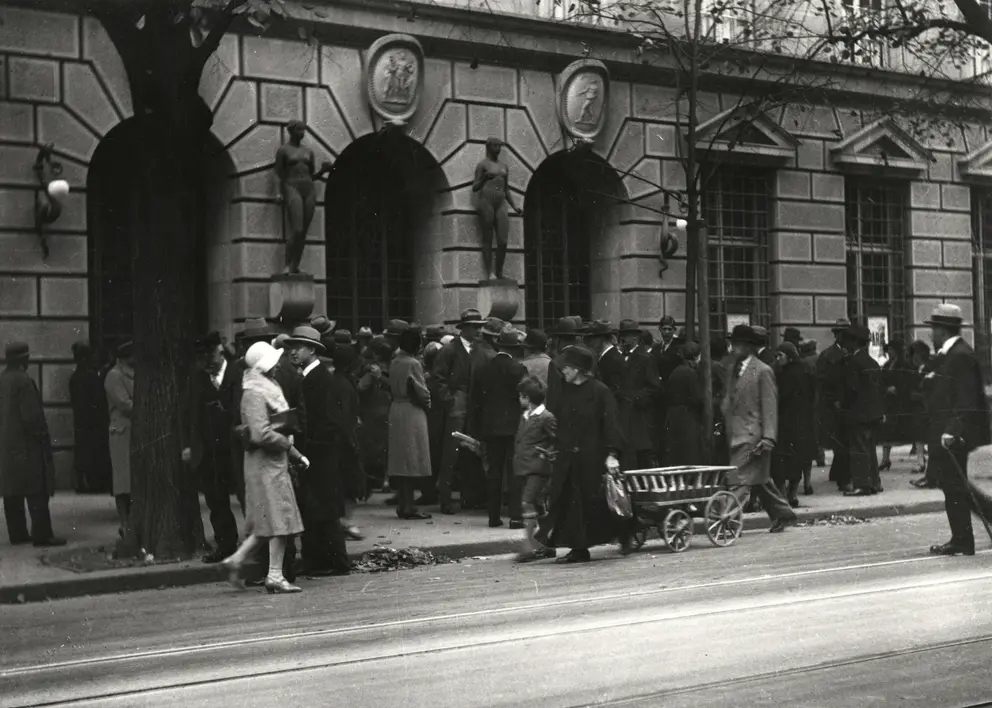The Swiss state as ‘an unwilling banker’

The rescue of Credit Suisse was not the second time a major bank was saved – nor was that of UBS the first. Back in the Great Depression, the Swiss government was compelled to save Schweizerische Volksbank (SVB) from collapse – and that time, it had the backing of a parliamentary resolution.
At 11am on Saturday, November 19, 1933, the finance ministry announced that Schweizerische Volksbank would “undergo a reorganisation” and that the government would contribute CHF100 million. It was an unprecedented event: the state bailed out a major bank with funds equivalent to a quarter of the annual federal budget.

More
Credit Suisse: the ‘credit locomotive’ has run out of steam
About a month earlier, the management of SVB had asked the government for state support. They had reached the conclusion that a restructuring of the beleaguered bank was not possible from within and “could only be made possible with state aid”.
The request did not come as a surprise: it had even been clear to the general public for some time that SVB was not in the best of health. As early as the end of September 1931, long queues had formed in front of its branches because anxious clients in Zurich began withdrawing their savings. The Frankfurter Zeitung described the scene as a “run on Schweizerische Volksbank”. But soothing statements from the bank’s management, the authorities and even newspaper editors allowed some calm to return just a few days later – at least on the surface.
A troubled ‘Mittelstand’ bank
At that time, the Swiss banking landscape was already structured similarly to today. The state-owned cantonal banks dominated the Swiss market, while the big banks dominated international business. The largest three of the then eight big banks were Schweizerische Kreditanstalt (SKA, later Credit Suisse), Schweizerischer Bankverein (SBV, part of the later UBS), and SVB (which was to merge into Credit Suisse in the 1990s).

More
Credit Suisse agrees to CHF3bn takeover by rival Swiss bank UBS
Although SVB was the second-largest bank in the country with total assets of around CHF1.7 billion and 1,600 employees, it was not considered a “typical big bank”. Rather than being structured as a joint-stock company, it was a cooperative and with its close-knit network of branches across the country, it was clearly more focussed on Switzerland than abroad. SVB was considered a “Mittelstand bank” for small savers and small businesses. “Successful savers bought medium-term bonds and became members of the cooperative. Families invested their entire assets with the Volksbank,” the government later explained.
But that was not the whole truth. SVB had long since expanded its sphere of activities, granting more loans to big companies and making larger investments abroad. This didn’t contradict its self-image as a “Mittelstand bank” – rather, it was a consequence of it. In the crisis years after the First World War, SVB suffered heavy losses, especially from its loans to Swiss family businesses in the embroidery, watchmaking and hotel industries. Since the bank didn’t want to burden its own cooperative members with these losses, it tried to compensate for them in foreign business.
This strategy initially worked but the foreign activities were risky. SVB lacked the competence for these adventures. This became obvious in 1929 when a large fraud was discovered at a French mill and SVB was one of the biggest victims.

More
Credit Suisse collapse: consequences and open questions
Members of the cooperative vehemently demanded a return to classic “Volksbank business”. SVB was “not a big bank, but a medium-sized bank that had become big”, they said at a delegates’ meeting. The new bank management tried to turn things around. But no matter what measures were taken, it was already too late: the stock market crash of 1929 in New York increasingly turned into a global economic crisis that led to immense losses at almost all big banks.
Heading for the rocks
After the “bank run” of 1931, SVB’s “restructuring” was constantly on the agendas of the government and the Swiss National Bank (SNB). Behind the scenes, an extremely unusual measure was taken: Alfred Hirs, a former SNB executive, was appointed crisis manager at SVB and reported to the SNB continually about SVB’s internal business. In principle, the SNB was prepared to provide state support, but didn’t want to discuss it in public. This was considered “particularly dangerous” at that time.
The SVB management continued to show a brave face to the outside world and even paid dividends to members of the cooperative, while the situation continued to deteriorate, almost across the board. Loans were not repaid, clients withdrew their deposits and members withdrew their ordinary shares – and there was no other bank able to step in to help.
It became increasingly clear that without rapid state help, the bank would soon collapse completely. So the authorities took action that was extremely swift for that time. Less than two months passed between SVB’s request to the government, the special parliamentary meeting at the end of November 1933 and the final parliamentary resolution of December 8, 1933, “on the financial participation of the government in the reorganisation of the Schweizerische Volksbank”.

More
How the Swiss ‘trinity’ forced UBS to save Credit Suisse
The Swiss government was now an “unwilling banker”, as the daily newspaper Der Bund put it. Under immense pressure, the process was ultimately approved by parliament. The parliament overruled the cooperative members of SVB, gave the government far-reaching powers, and withdrew the decision from a possible referendum. Edmund Schulthess, a member of the government, later explained that these emergency measures had to be taken “in the interest of maintaining our economy”.
The need for a state bailout for SVB was virtually undisputed by all the political parties and the entire press landscape. This had a great deal to do with the specific nature of SVB as a cooperative. “No other credit institution reaches so deeply into all echelons of the population”, said Der Bund. From the far left to the far right, there was agreement that SVB had to be rescued “to prevent small savers from losing money”, according to the left-wing newspaper Basler Vorwärts.
There was less agreement in the search for the culprits for the debacle, which began immediately. While the left-wing press blamed Radical Party representatives on the board of directors, the liberal newspapers saw the problem more generally in the cooperative structure. Nonetheless, there was agreement that such a state rescue operation should never happen again.
A political reappraisal began, and there were demands for legislation. Finance Minister Jean-Marie Musy said the enactment of the first Swiss banking law “could no longer be postponed for too long”. The draft, which had been lying in a drawer for some time, was now put forward to parliament in February and passed in September 1934. This banking law not only prescribed banking secrecy for the first time, but also introduced the most stringent supervision possible, with the aim of providing more security.
Emergency bailouts, however, remained unregulated. For the next 75 years, it was assumed that this was a one-off exception. The government was able to reduce its stake in the SVB after the Second World War, and SVB was taken over by Credit Suisse in 1993 – and was therefore indirectly rescued a second time by the state in 2023.
Literature:
- J. Baumann, Bundesinterventionen in der Bankenkrise 1931–1947. Eine vergleichende Studie am Beispiel der Schweizerischen Volksbank und der Schweizerischen Diskontbank, Diss., Zurich University, 2007 <https://www.zora.uzh.ch/id/eprint/163621/1/20070185.pdf>External link
- M. Mazbouri et al. ‘Finanzplatz Schweiz’ Wirtschaftsgeschichte der Schweiz im 20. Jahrhundert, Basel 2012, Pages 467–518.

More
Where did it all go wrong for Credit Suisse?

In compliance with the JTI standards
More: SWI swissinfo.ch certified by the Journalism Trust Initiative











You can find an overview of ongoing debates with our journalists here . Please join us!
If you want to start a conversation about a topic raised in this article or want to report factual errors, email us at english@swissinfo.ch.